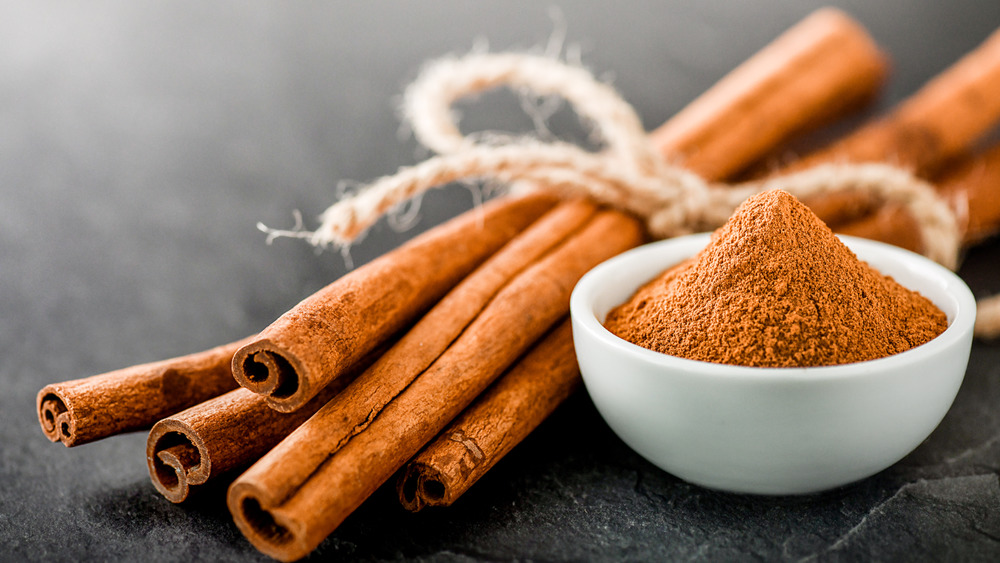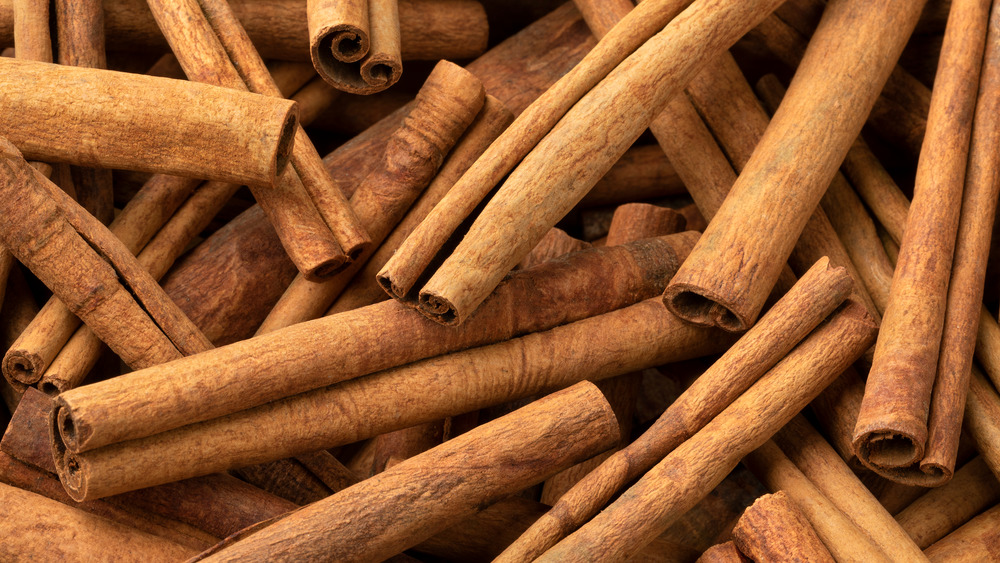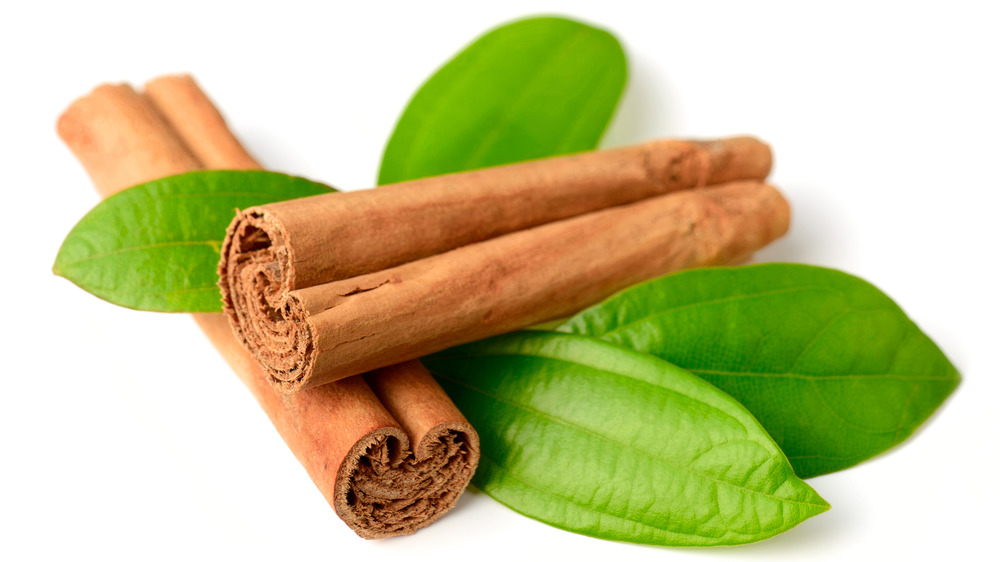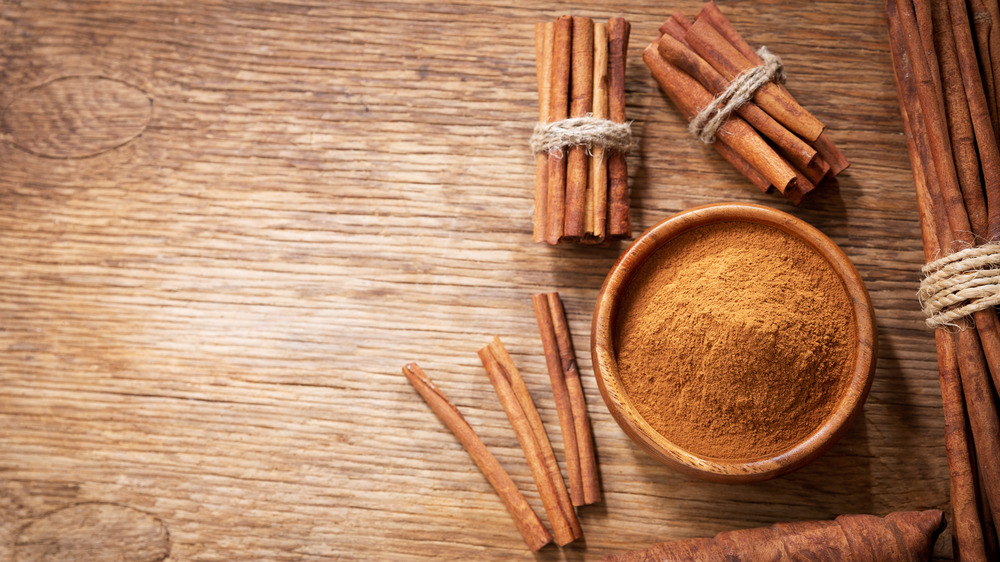This Is The Real Difference Between Cassia And Cinnamon
Are you sitting down? If not, you might want to grab a seat, because we have some pretty startling news that'll change how you see cinnamon forever: The ground cinnamon you have in your spice rack is likely not 100 percent "true" cinnamon, according to The Spruce Eats.
As it turns out, it's pretty common to combine what's called "true" or Ceylon cinnamon with its cousin, cassia, in most commercial ground "cinnamon" (AKA Ceylon cinnamon and cassia — does anyone else feel lied to?). Regardless of how often the two spices are nonchalantly combined and marketed as just "cinnamon," we need to talk about how cassia and Ceylon cinnamon, although related, are not the same thing. Not only do they taste different, but their sticks look different, they have different health benefits, they smell different, and one of them actually contains a toxin that can damage your liver if eaten regularly. But knowledge is power, right? So let's get to it.
Okay, so both true cinnamon and cassia come from the bark of the same tree and are harvested similarly, but after that, they live different lives. Cassia (Cinnamomum aromaticum or Cinnamomum cassia) is produced by harvesting, drying, and fermenting the tree's bark, then its outer layer is removed.
How is cassia different from true cinnamon?
After, cassia sticks curl inward from both sides, appearing like a scroll, which is different from how true cinnamon sticks curl (more on that later), according to The Spruce Eats. Cassia sticks are also rougher in texture, darker in color, and rolled into thicker sheets than true cinnamon (via Bon Appetit).
Appearance aside, cassia's flavor tends to be pretty intense, depending on which kind you get. Yes, there's more than one type of cassia: Indonesian, Chinese, and Saigon, all of which have different fragrances and flavor intensities. The one that's most common in the U.S. is Indonesian cassia, which is the mildest and sweetest of the three. (By the way, Indonesian cassia is the special ingredient used in Cinnabon's famous rolls, in case you were wondering.) On the other hand, if you're looking for an almost-spicy flavor, Saigon cassia is probably your guy. Saigon has a fairly distinct and intense smell, so it's pretty easy to distinguish from the other two. Lastly, Chinese cassia is typically used medicinally in China and isn't as common in the U.S.
With that being said, cassia tends to work best in savory dishes. Dried cassia buds that resemble cloves are often incorporated into spicy Eastern meat dishes in lieu of pickles, curries, and candies.
So, what's the lowdown on true cinnamon, then?
As far as the other parts of the cassia, its yellow flowers have a slightly cinnamon-y flavor, so they work well when preserved in a sweetened brine and used as a fragrance for sweets, fruits, teas, and wines, and its leaves can be used in lieu of bay leaves.
So, all of this sounds lovely, but there's something you should probably know about cassia: It contains very high levels of coumarin, which is a toxin and potential carcinogen, which, if consumed in large amounts, could lead to liver damage. Contrarily, Ceylon cinnamon contains none or very little coumarin.
As you have probably figured out, true cinnamon is native to Ceylon (formerly Sri Lanka). It's often used as a flavoring, embalming agent, preservative, and for medicinal properties, according to The Spruce Eats. In contrast to its cousin cassia, Ceylon cinnamon is best used in sweet baked goods.
In the early stages of producing Ceylon cinnamon (Cinnamomum zeylanicum), the process is similar to cassia, but a little more TLC is involved. When it's harvested, the sheets are usually processed by hand and rolled into very thin, fine, and flat layers (as opposed to cassia, which is often thicker), according to Bon Appetit. After it dries, the inner bark curls into thin strips (also called quills), forming a circle.
Cinnamon has surprising health benefits, too
Now, onto its taste. Ceylon cinnamon is super mild and delicate, even floral-like. There's definitely a stark contrast in flavor between true cinnamon and cassia, so using these two spices interchangeably isn't an easy task.
If you're shopping for ground cinnamon or cassia, it can be a little more challenging to determine what you're really getting than if you were shopping for sticks. We learned that cassia and pure cinnamon sticks have some subtle physical differences, but if they're ground up, well, obviously things are going to look a little different. The Spruce Eats suggests paying attention to differences in color and smell: "Cinnamon is warmer in tone and tan in color with a sweet flavor. Cassia is more of a reddish brown in color and has a more coarse texture, with a stronger, yet more bitter flavor."
While these are some pretty great pointers, we know that smelling and even looking at the contents of the spices you're buying at the grocery store isn't always possible. In that case, your best bet for finding true cinnamon is to look for the word "Ceylon." Another way to tell if it's the real deal? Its price tag. True Ceylon cinnamon is usually about four times as much as cassia cinnamon, but its health benefits make it totally worth it. You can even incorporate it into your beauty routine — there's evidence that eating cinnamon does good things for your hair.



